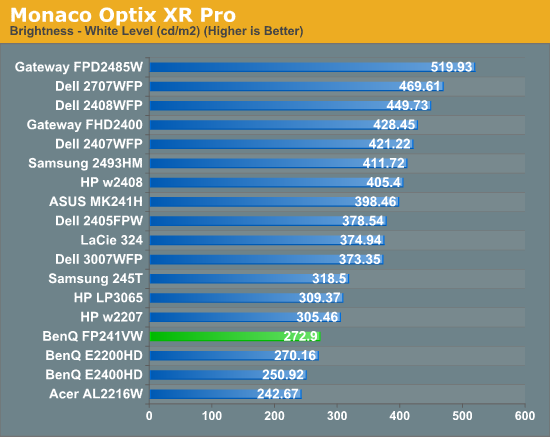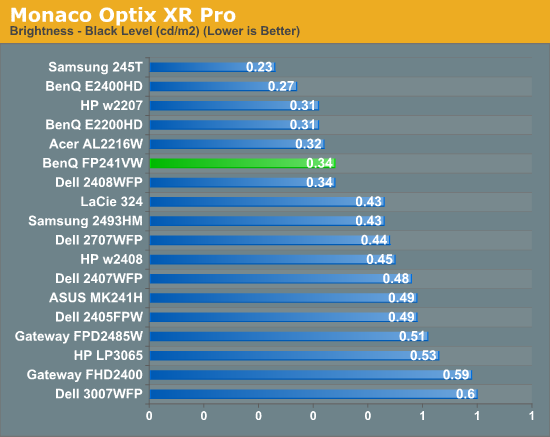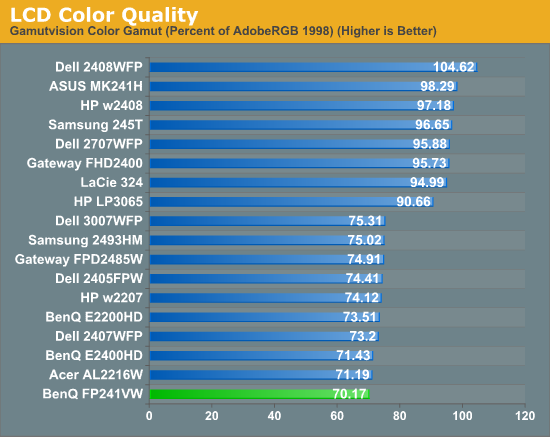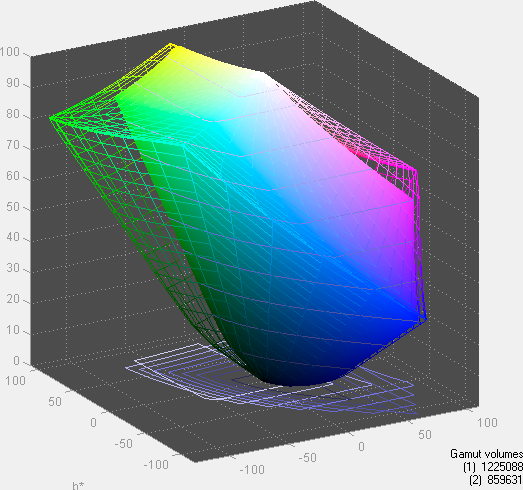Brightness and Contrast Ratio
For the brightness, contrast, and color accuracy tests, we depend on a hardware colorimeter and software to help calibrate the displays. We use a Monaco Optix XR (DTP-94) colorimeter and Monaco Optix XR Pro software, and we also test with ColorEyes Display Pro. Results in nearly every case have been better with Monaco Optix XR Pro, so for this article we're skipping the ColorEyes Display Pro results. We didn't perform a complete evaluation of the FP241VW, so we're missing maximum/minimum brightness results, but in general the display performs similarly to other LCDs.



Don't pay too much attention to the white/black graphs, as they are merely reference points for how the displays perform at certain settings. Like many other LCDs, the FP241VW has a "normal" brightness level of ~270 nits, which is more than sufficient and is actually brighter than what most users prefer to use in an office environment. You can reach the advertised 500 nits brightness if you adjust contrast and color levels as well. More important than brightness levels is the contrast ratio at the various settings. We measured a contrast ratio of 800:1 with the FP241VW, which is a decent result placing it in the lower mid section of our charts. While higher scores are better, in reality anything above 500 is sufficient for most users (i.e. the HP LP3065 that we like is at the bottom of the chart). Also, we wouldn't worry about any advertised dynamic contrast ratio numbers - at least not if you want consistent colors.
Color Gamut
Below is a comparison of color gamut for the LCDs we've tested. We use Gamutvision, a utility developed by Imatest LLC, to calculate color gamut. We compare the color profiles of the LCDs to the Adobe RGB 1998 color profile and report the results as a percentage - higher being better.


So far, color gamut has generally fallen into one of two categories: either +/-95% or +/-75%. Color gamut is determined almost exclusively by the backlighting, and the BenQ FP241VW falls short of other high-end LCDs in this area. In fact, it's at the bottom of the chart (though the difference between 70% and 75% isn't something you're likely to notice, so the bottom grouping essentially is a tie). For the original price, we would expect better, and if AU Optronics updates this particular panel we would definitely like to see a better backlight. Ideally, what we would like to see from more manufacturers is the use of LED backlighting - you can get extremely high color gamuts using RGB LEDs, and power requirements are also lower than traditional CCFL backlights. It's important to keep things in perspective, however: 70% may seem very low, but if you are using the standard sRGB profile (Windows' default) these LCDs look fine. It's only in applications like Adobe Photoshop with its expanded color space that you might notice a difference between the display color gamuts.










114 Comments
View All Comments
TA152H - Saturday, June 20, 2009 - link
Even back 20 years ago, only a certain amount of companies made shadow masks too. Nanao did not make their own, but, yet, their screens were the best. It's not as simple as you make it sound.It's actually possible that NEC might make a better monitor in some instance, although I've never seen it, but, by and large, Eizo is much better. You know when you're looking at an Eizo.
The picture quality is much better than NEC, or anyone else. I'll say this though, I have had uneven reliability with Eizo. Some monitors have been fine, and but more than there should be died quickly or had intermittent problems they should not have. This happens with all monitors, of course, but, in my small sample set, Eizo monitors have had more problems than others, but a small degree.
Clearly, all that money is put into picture quality, not reliability.
darklight0tr - Wednesday, June 17, 2009 - link
Expensive != Quality and Eizo is proof of this.Our internal graphics department recently moved to 24" Eizo monitors at $1700 a pop and HATE them. They are inconsistent across the display, and are no better than the standard DELLs we use for the rest of the environment. They had high expectations for those displays and were really let down and the Eizo rep was no help at all. Its funny how communication diminished as soon as the sale was completed.
What a waste of money.
TA152H - Saturday, June 20, 2009 - link
It's funny, because two people where I work got two Eizo's, and everyone wants them, and comments on them.Even on independent reviews, when they actually do get reviewed, they always are rated extremely highly, except for price. I don't know why your experience would be so much different, but, it sounds like you guys are either stupid (for not looking at the monitors first before buying a bunch), or it's made up.
Probably the latter, since no one would buy a monitor that was really expensive without seeing it and judging it first.
darklight0tr - Monday, June 22, 2009 - link
Wow, a whole two people. What a great example you have there.We have a whole department with them (almost 20 monitors) and while they work okay, most of them don't live up to the price tag. As I said, the colors aren't consistent across the display, even after calibration (yeah, us stupid people actually know how to do that). This happens with pretty much every one we have. We didn't buy them sight unseen either, which would have been pretty moronic. I think it is the backlight that causes many of the issues, which is unfortunate. I hope LED backlight displays help with this problem.
Who cares if they are reviewed well? I have them here in person and they don't live up to the price OR the reviews.
Calling me stupid, how mature. How about not judging me based on your own limited experience?
JarredWalton - Wednesday, June 17, 2009 - link
See, that's the problem: server CPUs start out as super fast but the tech makes its way to consumer products. The same thing has happened with GPUs, HDDs, RAM, etc. to varying degrees - it's all substantially cheaper now and performance has improved. But LCDs? Well, Eizo makes high quality LCDs, certainly, but they cost an arm and a leg. The cheapest 24" Eizo (taking a quick look) is over $800, with other models costing $1500 or more. They may be the best displays on the market, but what I want is to see that quality make its way into $500 LCDs.Spoelie - Wednesday, June 17, 2009 - link
http://translate.google.com/translate?prev=hp&...">http://translate.google.com/translate?p...mp;sl=nl...Launched in japan just yesterday with a $500 pricetag...
Now if only they would sell it abroad as well with a similar pricetag. And we need a review, it's "VA" technology but which one?
Mastakilla - Wednesday, June 17, 2009 - link
Eizo is not at all that good for it's priceFor a similar price you get a muuuuuuch better NEC monitor (check out the xx90 series)
Griswold - Wednesday, June 17, 2009 - link
Not going to happen. Well, maybe eventually the cheapos arrive at todays quality of Eizo, but then Eizo would have moved beyond that again. :PQuality and spending a few hundred bucks just doesnt go together. Buy Eizo and be happy for many, many years - not only due to the 5 years on-site warranty (not that I've ever had to make use of it, though..)
HexiumVII - Wednesday, June 17, 2009 - link
I've been using of those old Soyo 24" with the MVA I got for $250 a few years back, its great, has all the advantages of MVA and color is very accurate with my spyder. At school we have 24" iMacs and the screen is just friggin amazing. It's just so much better than everything else out there. A lot of it has to do with the glossy screen. So here's to a 24" 16:10 screen with gloss for a reasonable price one day.marraco - Wednesday, June 17, 2009 - link
I got crazy trying to play Crisys 2 at the morning on a glossy monitor. There was no way to see clearly the image without reflections. There was no way to accommodate the monitor to reduce reflex.glossy is an absolute crap. I hate it from gut.